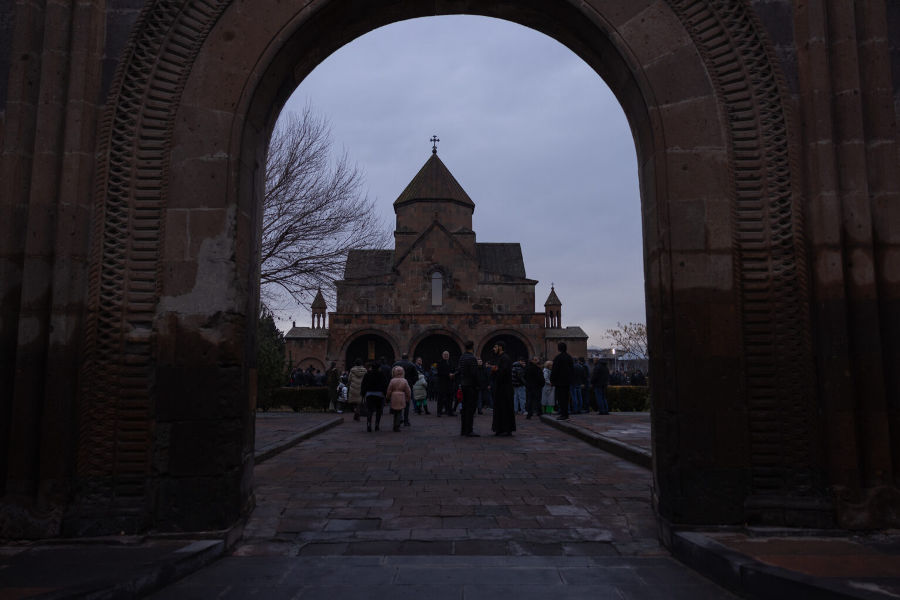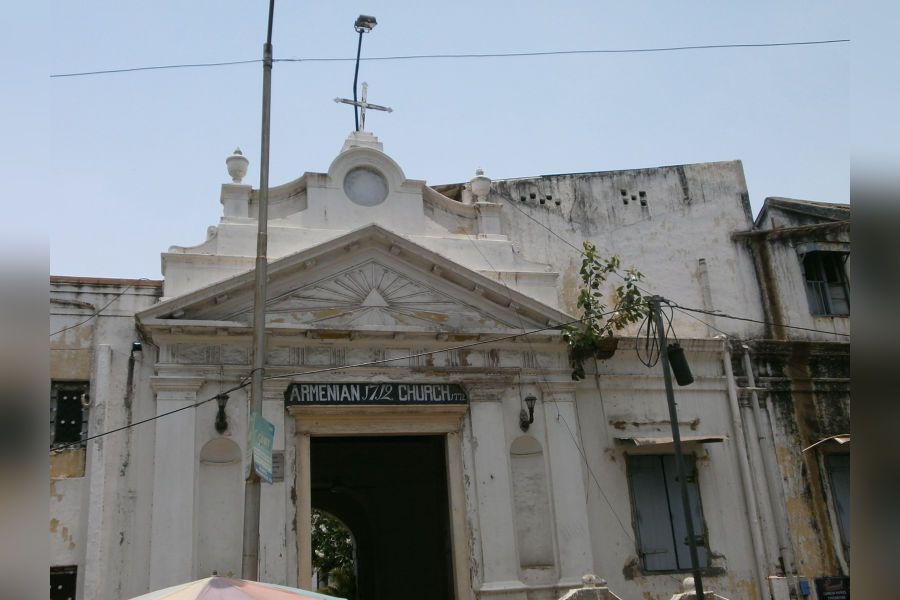
We often refer to two simple terms, community and diaspora, and they are subject to significant complexity and interpretation. Our global diaspora was essentially an outcome of the atrocities from 1894-1923. There were Armenians in the United States prior to this period, but their sense of community was limited. Many believed that their presence was temporary and that they would return to the homeland. Many of our grandfathers came to these shores under those circumstances and became separated from their families during World War I. Every family has a story of tragedy, reunification and resettlement.
The diaspora has also experienced shifting demographics with significant migration from the Middle East from the late 1950s through the 1970s, due in large part to political instability and loss of economic opportunity. Wholesale expulsion, a weapon of genocidal criminals, continued in the late 1980s and early 1990s when hundreds of thousands of established Armenians were deported from Azerbaijan.
The diaspora is a convenient term for those living outside of the homeland in a dispersed state. For over 100 years, Armenians have fought assimilation by investing in physical, organizational and programming infrastructure to maintain an Armenian identity among the millions who live in the diaspora. There is no doubt that the successes and capabilities of the western diaspora have been aided by periodic migration from locations such as the Middle East, Azerbaijan and Armenia. These immigrants have been essential to populating many locales and providing important programming with their cultural skills. In addition, it is a sociological phenomenon that we have fifth and even sixth generation Armenians born in this country who are active contributors to the Armenian nation.
There are significant contrasts between diaspora locations, as each has absorbed some portion of the culture of its host nation. This is where the iconic “hyphenated” identity finds its roots. As American-Armenians, we have established a subculture that has maintained a core that unites us, while adopting certain aspects of American life. There are positive aspects of this, as Armenians are well educated and have established an influential advocacy arm for Armenian interests. On the other hand, we have witnessed the loss of the mother tongue among many active members of the diaspora. This has become a cultural divide between those who consider fluency essential to Armenian identity and those who do not have fluency. The diaspora locations can be viewed as a dynamic Venn diagram, with a constant struggle to maintain the overlapping commonality.
How does the diaspora manifest itself in its chosen geographies? The diaspora is organized through a community structure. Economics always drives the choice of location, as Armenians settle in areas based on employment and quality of life. That attribute continues to be significant as we witness the decline of some traditional locales and the emergence of new communities such as Charlotte, Las Vegas and Tampa. The Armenian church has been the pillar around which our communities have been built. This started in the early communities such as Worcester, Fresno and New York City and is true in the more recent entities. When the survivor generation arrived on these shores, they brought their identity with them. The church was usually the physical center of village life in the western highlands prior to the Genocide. In the new world, the church became not only the spiritual center but also the representation of our communal identity. It was from the church that language schools, affiliated benevolent organizations and youth activities emanated.

A similar model has held true with most recent developments. When a reasonable amount of people gather in a new geography, they usually organize cultural activities and a mission parish. Many of these mission parishes have evolved into organized parish communities. Examples include Tampa, St. Petersburg, Charlotte and most recently Jacksonville, Florida. The traditional political parties played a vibrant role in helping communities organize in the beginning. The organizations, particularly the ARF, were instrumental in allocating resources to build churches, centers and clubs (agoomps). When the revolutionary period ended after the fall of the first republic, political parties such as the ARF focused on establishing infrastructure in the diaspora and had a major impact on transitioning a population of Armenians into a community. I know that in many communities, such as Indian Orchard, it was these resources that made it possible for leadership to establish permanent structures from 1920 through the First World War.
In last week’s column, I referred to community as “a fellowship that reflects shared goals and interests.” The diaspora has become a network of communities that are constantly evolving as economics, demographics and other factors continue to change. If the diaspora is the aggregation of networked communities, what is the essence of these communities? It is true in its simplest form that our communities are the people who choose to identify as American-Armenians, for example, but a closer look at the decision making and resource capabilities of our communities reveals an organizational affiliation dynamic.
By understanding the structural nature of our communities, we can develop opportunities to optimize our resources and produce the best results. Our communities are the result of cooperative organizations that share a vision of Armenian identity.
Our communities include the church (Apostolic, Protestant and Catholic), ARF, ARS, AGBU, Hamazkayin, AYF, ACYOA and countless others. Each has established its position based on, in some cases, decades of service and historical alignment. The latter is quite dynamic. As old stereotypes diminish, new paradigms emerge. For example, there was a time when very few Prelacy or Dashnag affiliated individuals would have been prominent in the Knights of Vartan or NAASR. This is no longer true. Both groups have become representative of the greater community. We are still overly focused on which groups we align with (particularly the church), but even those walls are crumbling. Today’s generation cares little about historical divisions and is more focused on the pan-Armenian mission. To understand the composition of our communities, and eventually the diaspora, we must immerse ourselves in the local organizational structure and the interplay that governs our communities. Many groups, in order to promote a more pan-Armenian theme, declare they are “unaffiliated” in order to distinguish themselves from any remaining divisions. It is essential to acknowledge that all groups, regardless of affiliation, form what we refer to as our community.
What fuels our concept of community in the diaspora? At the bottom of the pyramid is the need for identity. All organizations and communities operate with individuals who have chosen to identify as Armenian. Therefore, assimilation in terms of ethnic identity is a major threat. Assuming that identity can survive, then affiliating with an organization or church is essential. This should never be underestimated. Studies have shown that the current generation is less likely to join communal groups. A smaller percentage of people are getting married, and when they do, it is not uncommon for it to happen years later than in previous generations. As a result, children are born later in their parents’ lives. The impact of this is that “settling into life” is occurring later, with less connection to legacy organizations. These sociological factors in America have a direct impact on community building. Of course, lack of community participation does not necessarily mean a lack of ethnic identity. It is analogous to a lack of church participation not necessarily meaning a lack of faith. The reality is that we can pray on our own, but we only worship as a group — a community. Likewise, we may identify as an Armenian individually, but we are only a community together.
The solution lies in our sense of community: a fellowship of people sharing common interests and goals. It is for this reason that our communities must always focus on the goals that bring us together. I love it when people say to each other, I am from Granite City, Washington or Worcester. The community structure has its own culture and is a repository for a sense of pride. When I talk to people, I always say that I live in the Boston area but am from Indian Orchard. This is where I draw my communal affiliation and identity. We hear these comments all the time at AYF Olympics or when visiting friends in other geographies. A few weeks ago, we hosted a kebob cookout for some friends we met in the AYF from around the country. We were thrilled and surprised by the presence of a dear friend from Montreal. Our conversations took on three forms: his community, his family and global Armenian issues that connect us on a common platform. I thought about our gathering later that evening after our guests had left. Family, community and Armenia are the trifecta that constitute who we are. Like many of you, we usually skip American politics, because we choose to focus on what unites us. There is plenty of room for spirited dialogue within these boundaries.
Our mission, wherever we reside, must be to build a sense of community identity that bonds our participants together beyond organizational affiliations. Organizations are the means, while our sustainable identity is the end. Each of us has the opportunity to look at our affiliations in the context of the greater mission that is found in pan-Armenian thinking. Our communities are cultures in and of themselves. Each of our contributions help define that culture. They evolve through external and internal factors. Identity in the diaspora is always a choice. Let us choose community.







